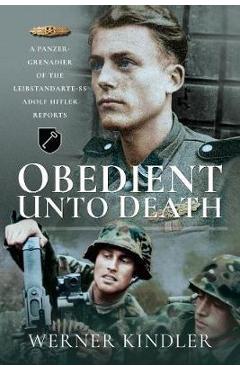Obedient Unto Deat. - Werner Kindler

Detalii Obedient Unto Deat. - Werner
Vânzător
libris.ro
Pret
86.64 Lei
86.64 Lei
101.93 Lei
Categorie (vânzător)
History
Marca
Werner Kindler
Descriere YEO:
Descriere magazin:
Drafted into the SS-Totenkopf in 1939, Werner Kindler served with a motorized unit in Poland before, in May 1941, he was selected for the elite Leibstandarte-SS Adolf Hitler. It was with the Leibstandarte-SS Adolf Hitler that he participated in Operation Barbarossa, the invasion of the Soviet Union from June 1941. Werner\'s unit converted to a Panzer Grenadier formation in 1942, and he went on to fight at Kharkov and Kursk on the Eastern Front. Having transferred to the Western Front in 1944, Werner later fought in Belgium and France, in the Ardennes campaign, in Hungary and, finally, in Austria, Between 1941 and 1944 Waffen-SS Oberscharf hrer Werner Kindler took part in eighty-four days of close combat. As a result, he was awarded the Close Combat Clasp in Gold (for participation in more than fifty battles) on 1 April 1945 - being one of only 631 men who received this decoration. He was also awarded the German Cross in Gold, the Iron Cross First and Second Class, the Eastern Front Medal and the Gold Wound Badge, having been wounded six times in action. At the end of the war in Europe, Werner was one of the last men of the Leibstandarte-SS to surrender to the Americans. Obedient Unto Death is one of the most dramatic firsthand accounts to come out of the Second World War. It provides is an unparalleled insight into the reality of close combat on the Eastern Front, where infantrymen attacked tanks with hand grenades and limpet mines, as well as the creation and evolution of armored forces during the Second World War.

Obedient Unto Deat. - Werner - Disponibil la libris.ro
Pe YEO găsești Obedient Unto Deat. - Werner de la Werner Kindler, în categoria History.
Indiferent de nevoile tale, Obedient Unto Deat. - Werner Kindler din categoria History îți poate aduce un echilibru perfect între calitate și preț, cu avantaje practice și moderne.
Preț: 86.64 Lei
Caracteristicile produsului Obedient Unto Deat. - Werner
- Brand: Werner Kindler
- Categoria: History
- Magazin: libris.ro
- Ultima actualizare: 15-03-2025 01:47:23
Comandă Obedient Unto Deat. - Werner Online, Simplu și Rapid
Prin intermediul platformei YEO, poți comanda Obedient Unto Deat. - Werner de la libris.ro rapid și în siguranță. Bucură-te de o experiență de cumpărături online optimizată și descoperă cele mai bune oferte actualizate constant.
Descriere magazin:
Drafted into the SS-Totenkopf in 1939, Werner Kindler served with a motorized unit in Poland before, in May 1941, he was selected for the elite Leibstandarte-SS Adolf Hitler. It was with the Leibstandarte-SS Adolf Hitler that he participated in Operation Barbarossa, the invasion of the Soviet Union from June 1941. Werner\'s unit converted to a Panzer Grenadier formation in 1942, and he went on to fight at Kharkov and Kursk on the Eastern Front. Having transferred to the Western Front in 1944, Werner later fought in Belgium and France, in the Ardennes campaign, in Hungary and, finally, in Austria, Between 1941 and 1944 Waffen-SS Oberscharf hrer Werner Kindler took part in eighty-four days of close combat. As a result, he was awarded the Close Combat Clasp in Gold (for participation in more than fifty battles) on 1 April 1945 - being one of only 631 men who received this decoration. He was also awarded the German Cross in Gold, the Iron Cross First and Second Class, the Eastern Front Medal and the Gold Wound Badge, having been wounded six times in action. At the end of the war in Europe, Werner was one of the last men of the Leibstandarte-SS to surrender to the Americans. Obedient Unto Death is one of the most dramatic firsthand accounts to come out of the Second World War. It provides is an unparalleled insight into the reality of close combat on the Eastern Front, where infantrymen attacked tanks with hand grenades and limpet mines, as well as the creation and evolution of armored forces during the Second World War.
